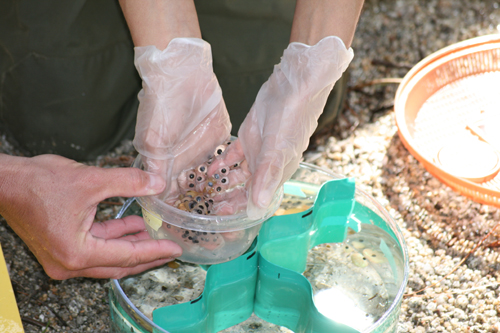
The chances of preserving the endangered mountain yellow-legged frog have taken some set backs in the past two years. Not only has the severe drought taken its toll on the frog’s habitat, but the torrential rainstorms, which drenched the Mountain Fire in July 2013, severely damaged the habitat of one of the few remaining natural MYLF populations.
“The monsoonal rain was heavy and short duration,” said Adam Backlin, an ecologist with the U.S. Geological Survey’s Western Ecological Research Center. “It washed out sediment and buried their pools.”
In general, Backlin described the recovery efforts and the frog’s re-established population as “Not doing great, Last year was probably tough all over for it.”
The drought has dried up streams, which destroys the aqueous habitat necessary for the frog’s life cycle.
“They need perennial water,” Backlin said. For example, this species’ tadpoles require two years before morphing into adult frogs. The tadpoles require pools of running water.
After the Mountain Fire, the storm damage essentially destroyed the pool locations and the drought has limited the availability of running water, according to Backlin.
Since this population was already small, Backlin thinks it is unlikely any have survived, but he hopes to visit the area this summer to investigate.
Several efforts to restore a MYLF population at the James Reserve have had limited success, according to Backlin. Researchers have experimented with re-planting different age classes, from recently fertilized eggs to young adults. The use of tadpoles has had limited success, he said.
Two years ago, when they released adult frogs, which had been raised in captivity, they achieved the greatest success. The frogs, which had radio transmitters attached, were all alive a year later.
But the natural habitat can also be dangerous to the zoo breed frogs. Batrachochytrium dendrobatidis, a fungus, appears to be native to these areas and causes a disease called chytridriomycosis. With drought conditions present in the habitat, many frogs are dying from this. However wild frogs appear to develop or find an anti-fungal bacteria in the habitat and are less susceptible to this threat.
“The drought is putting a lot of stress on them. Which allows the pathogen to take advantage,” Backlin said.
At this time, Backlin said researchers may release a few more frogs later this Spring. But these efforts are also being stifled. Breeding success in the zoos has diminished; therefore there are fewer frogs available for release.









